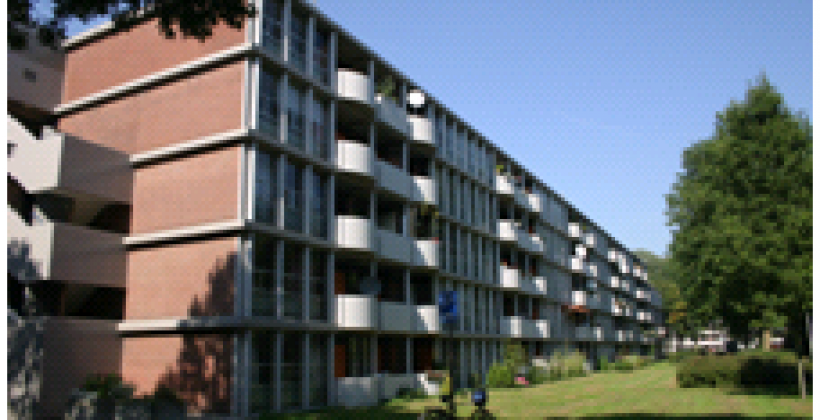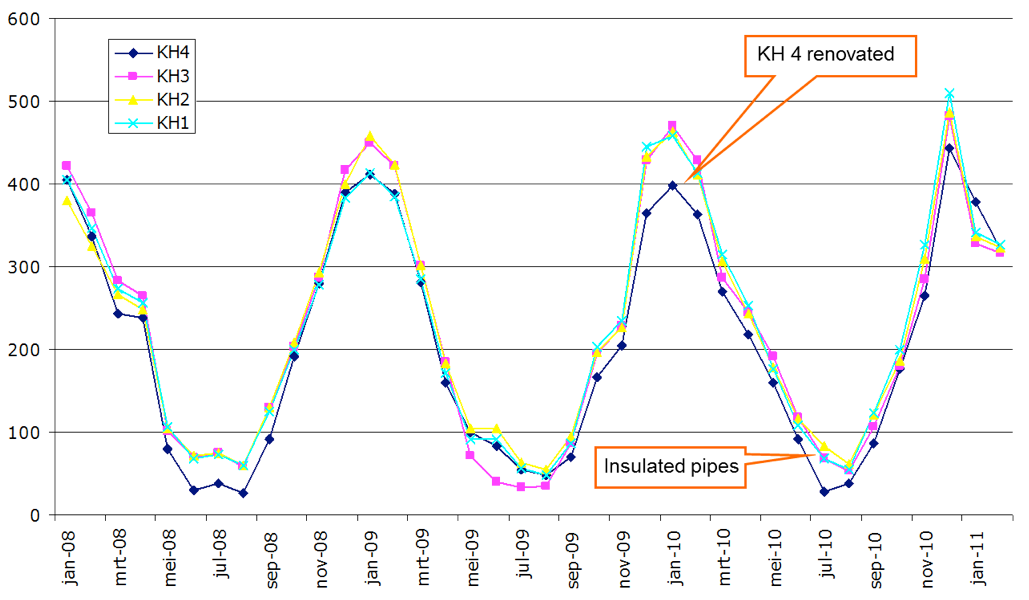
Location
Description
Amsterdam-Noord, one of the 14 districts of the city of Amsterdam, has been developed rapidly in the post war period. For most of these buildings renovation is required, both from a technical as well as from a social point of view. Within STACCATO an approach with an enormous impact on sustainability is demonstrated in a project of 1,172 dwellings called Het Breed. Het Breed is a much talked about housing complex designed by architect Van Gool and built in the 1960’s. It exists of 11 five-storey buildings all connected by air bridges, a relic from the old airport. The dwellings are owned by two housing associations. A certain number of houses will be sold.
The renovation of the dwellings started in September 2008. Unfortunately it was stopped after 1 month due to various problems. A restart was scheduled in spring 2010. Meanwhile the integration of a sustainable energy system into the energy supply system is carried out.
Het Breed in the district Amsterdam Noord is part of the concerto project STACCATO. Picture 1 - New boiler room at Het Breed with gas peak boilers Picture 2 - Buffer tanks Picture 3 - Solar thermal collectors on the roof and the gas absorption heat pumps on the right Picture 4 - Installation of the new pipes and ducts Picture 5 – New energy distribution pipes in the ceiling of a gallery
Documents
Site facts and figures
- Estimated population involved: 3,164
- Approx. geographical area coverage: Information will follow
- Approx. energy saving: 5,073 MWh/y electricity and 7,805 MWh/y heating
- Approx. energy from RES: 9,062 MWh/y heating
Technologies
Technologymix
In Amsterdam “Het Breed” the renovation of 11 housing blocks (1,176 dwellings) began in May 2008. They had been built between 1963 and 1967 and now are getting new insulation at roof and floor, new double glazing in the façade and replacement of the building services.
Space heating and domestic hot water for the 11 buildings is produced in four boiler houses. The old gas boilers are replaced by new high efficiency gas boilers (Picture 1) that generate energy mainly for space heating. In two boiler houses, in total 20 gas absorption heat pumps (700 kW total) complement the heat generation of the gas boilers.
Solar thermal collectors (Picture 2 + 3), newly installed on the roofs of the buildings, deliver the heat for the domestic hot water. Space heating and domestic hot water are transported to the flats via separate small local district heating networks. All central heating pipes and water pipes in the ceilings of the buildings’ galleries have been replaced and well insulated.
After the refurbishment of the flats, the use of low temperature heating (65 °C instead of 90 °C) brings CO2-emissions further down.
Furthermore, 217.5 kWp photovoltaic systems have been installed on the building blocks of Het Breed in December 2012.
In Het Breed, Amsterdam Noord, heat for heating and domestic hot water is generated in four boiler houses and distributed to the 1,176 dwellings of Het Breed via separated heating and domestic hot water networks. The boiler houses contain gas-fired high efficiency boilers (in total 8.9 MW), 20 gas absorption heat pumps (in total 0.7 MW) and large buffer storages for the hot water. These short-term buffer storages are filled with hot water provided by the 4 solar thermal plants on the roof of the buildings nearest to the boiler houses. The total area of the flat plate collectors is 1,230 m² (area of 251 m², 301.2 m², 326.6 m² and 351.4 m²) delivering heat for the domestic hot water. Due to the stochastic nature of solar radiation and its periodical availability, storages for the solar energy are necessary and were installed in the system. The domestic hot water system requires technically relatively simple storage units, though they have to be well insulated to minimize heat losses. In Het Breed, a total storage volume of 56,700 litres has been installed and provides the inhabitants of Het Breed with eco-friendly generated domestic hot water. In case the stored solar energy is insufficient to cover the demand, the gas-fired boilers supply the heat for the heating and contribute to the domestic hot water network.
All central heating pipes (Picture 4) and water pipes in the ceilings of the galleries (Picture 5) have been replaced and insulated. Figure 3 shows the location of the four boiler houses and in blue the new energy distribution network.
The monitoring results of the second year present a 20% reduction of energy consumption through the refurbishment of boiler houses and a new energy distribution system (Figure 4, retrofitted boiler house 4 compared to the at that time unchanged other boiler houses).
The dwelling-related measures like insulating the roof, renewing and extending the radiators in the flats, replacing the glazing etc. started after 70% of the tenants approved the refurbishment in February 2013. According to the planning, every week 10 dwellings will be delivered.

Figure 3 – Location of boiler houses and new energy distribution (blue lines)

Figure 4 – First monitoring results from second year

Figure 5 – Energy systems and metering points in boiler house 4

Figure 6 – Energy systems and metering points in boiler house 2
The CONCERTO approach
The project backers want Amsterdam to be a stepping stone for the implementation of energy efficiency measurements and renewable energy sources in other redevelopment areas.
A major challenge for Dutch housing associations is to obtain approval from tenants of buildings scheduled for renovation. More than 70% of tenants must agree to the renovation before it can start. Therefore a very high level of communication is important.
Highlights
The project incorporates far reaching insulation measures up to the level of new housing. The sustainable energy measures are even more ambitious than the requirements for new housing and will be an example for similar existing housing projects in the area and other cities.
For the renovation period, the tenants can chose between staying in their apartments or using a temporary dwelling.
